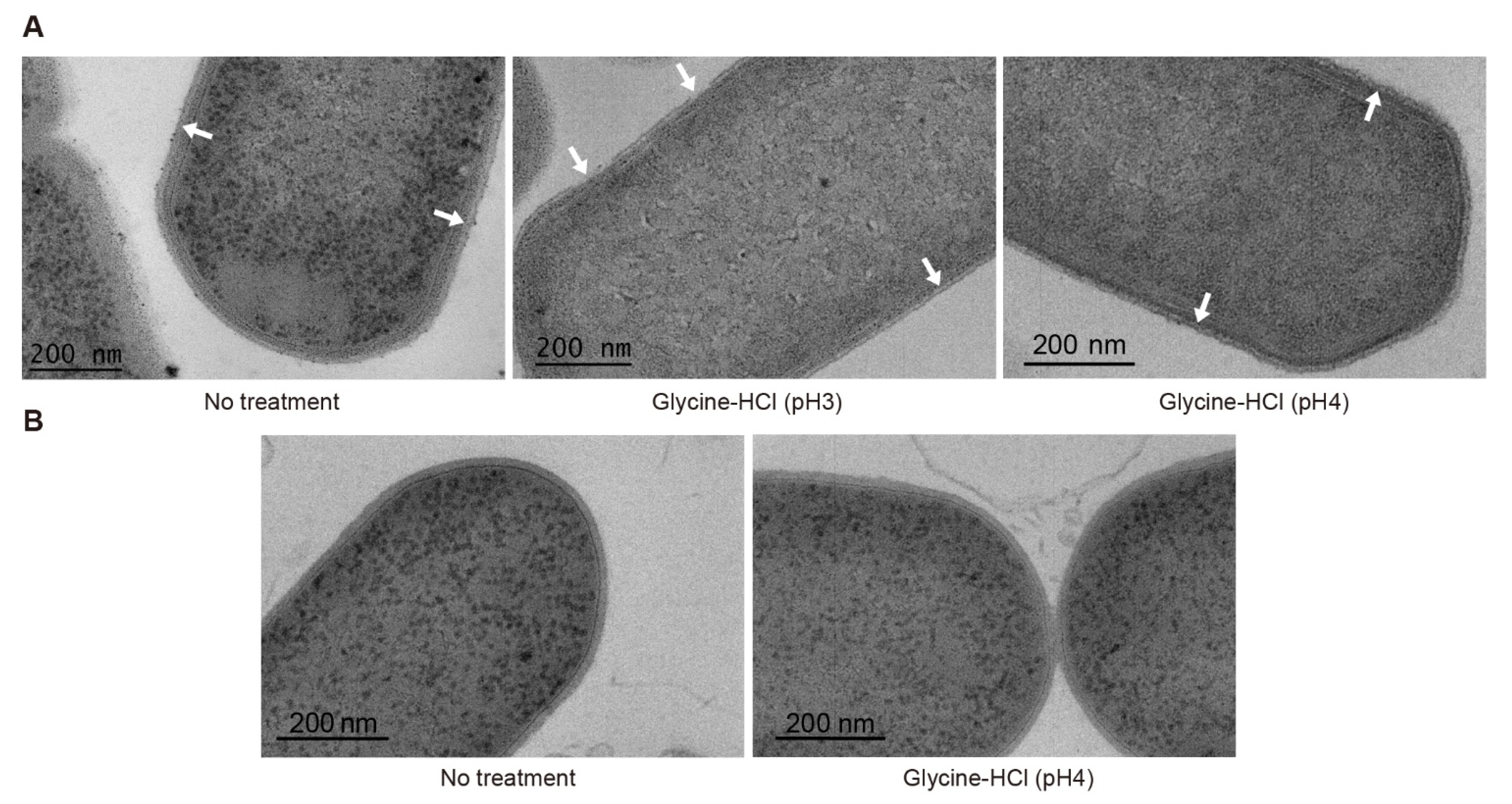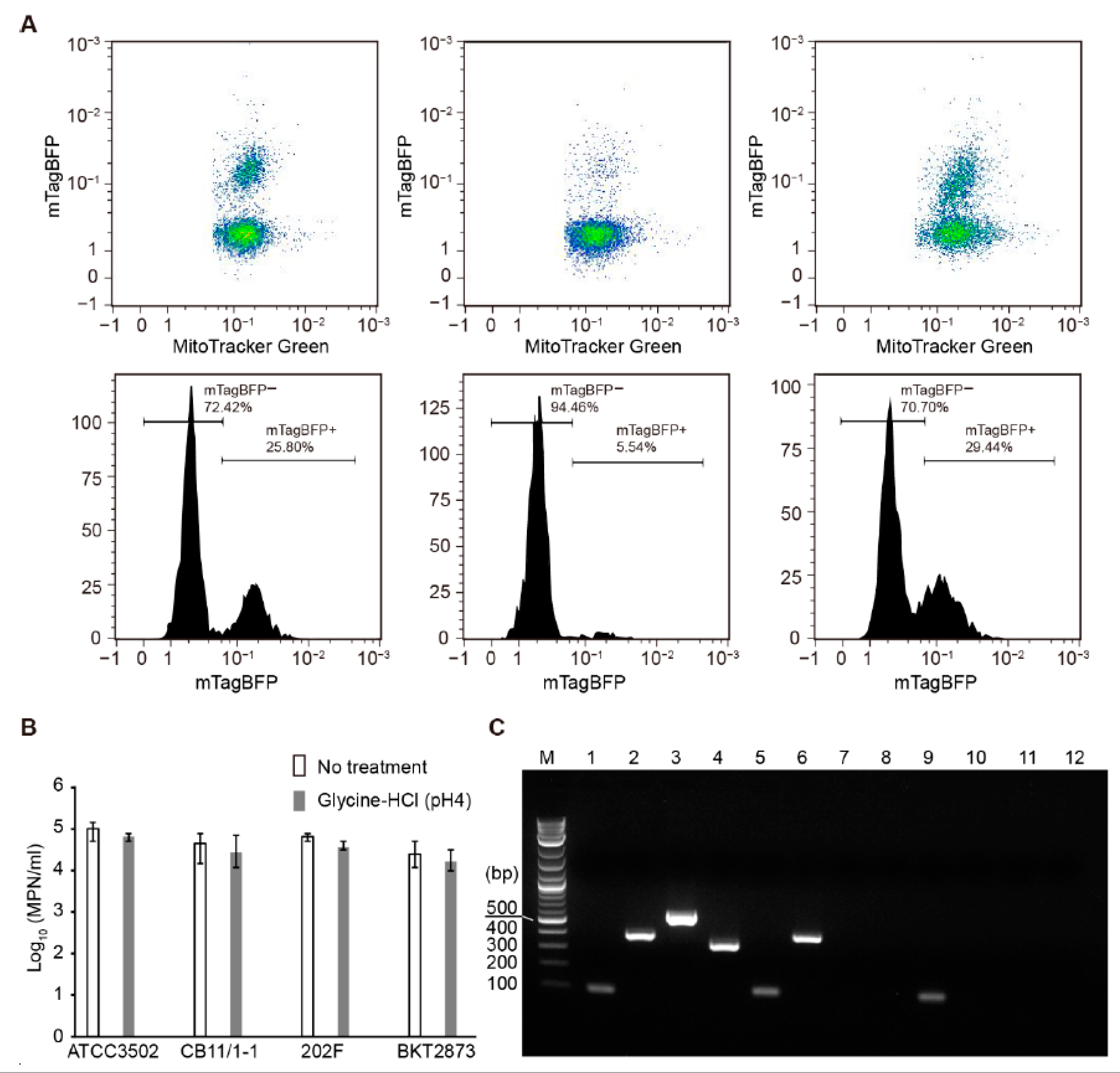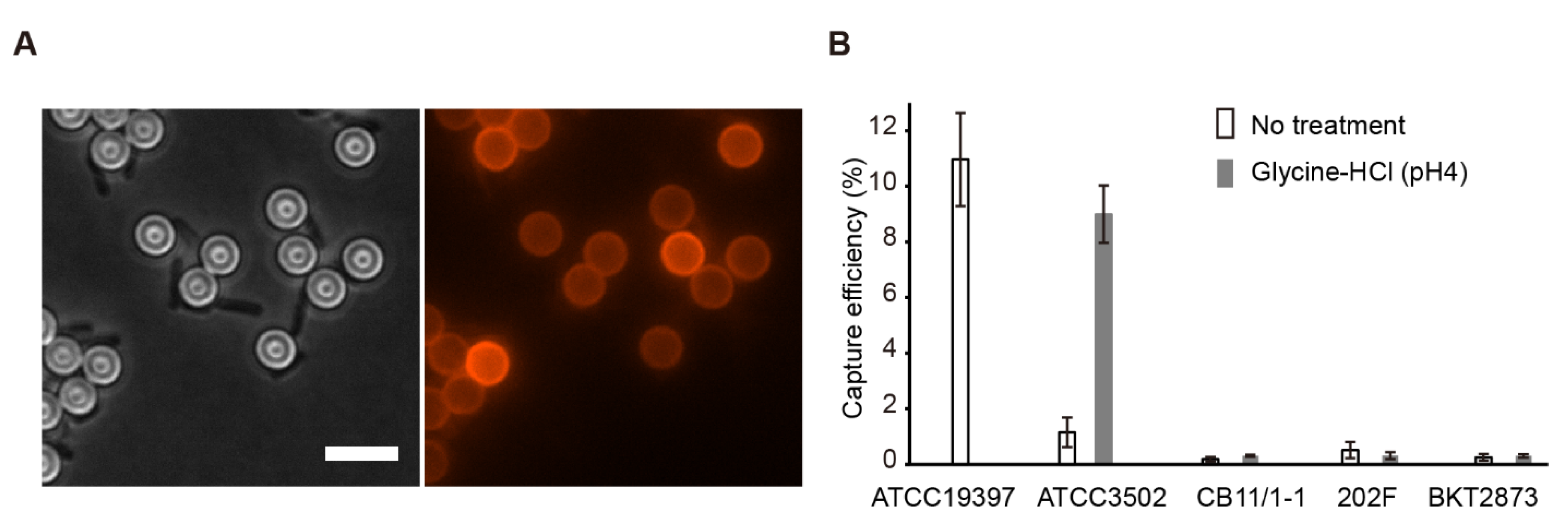Specific Isolation of Clostridium botulinum Group I Cells by Phage Lysin Cell Wall Binding Domain with the Aid of S-Layer Disruption
Abstract
:1. Introduction
2. Results
2.1. Enhanced Binding of CBO1751 CBD to Clostridium botulinum ATCC3502 Cells by S-Layer Disruption
2.2. Binding Specificity of CBO1751 CBD
2.3. Flow Cytometry Separation of Clostridium botulinum Group I
2.4. Magnetic Separation of Clostridium botulinum Group I
3. Discussion
4. Materials and Methods
4.1. Bacterial Strains and Culture
4.2. Expression and Purification of mCherry-CBD and mTagBFP-CBD
4.3. Fluorescence Microscopy
4.4. Transmission Electron Microscopy
4.5. Flow Cytometry Separation
4.6. Magnetic Separation
Supplementary Materials
Author Contributions
Funding
Institutional Review Board Statement
Informed Consent Statement
Data Availability Statement
Acknowledgments
Conflicts of Interest
References
- Peck, M.W. Biology and genomic analysis of Clostridium botulinum. Adv. Microb. Physiol. 2009, 55, 183–265. [Google Scholar] [CrossRef] [PubMed]
- Smith, T.; Williamson, C.H.; Hill, K.; Sahl, J.; Keim, P. Botulinum neurotoxin-producing bacteria. Isn’t it time that we called a species a species? MBio 2018, 9, e01469-18. [Google Scholar] [CrossRef] [PubMed] [Green Version]
- Weigand, M.R.; Pena-Gonzalez, A.; Shirey, T.B.; Broeker, R.G.; Ishaq, M.K.; Konstantinidis, K.T.; Raphael, B.H. Implications of genome-based discrimination between Clostridium botulinum group I and Clostridium sporogenes strains for bacterial taxonomy. Appl. Environ. Microbiol. 2015, 81, 5420–5429. [Google Scholar] [CrossRef] [PubMed] [Green Version]
- Wentz, T.G.; Tremblay, B.J.; Bradshaw, M.; Doxey, A.C.; Sharma, S.K.; Sauer, J.D.; Pellett, S. Endogenous CRISPR-Cas Systems in Group I Clostridium botulinum and Clostridium sporogenes Do Not Directly Target the Botulinum Neurotoxin Gene Cluster. Front. Microbiol. 2021, 12, 787726. [Google Scholar] [CrossRef]
- Solomon, H.M.; Lilly, T.J. Chapter 17: Clostridium botulinum. U.S. Food and Drug Administration. 2001. Available online: https://www.fda.gov/food/laboratory-methods-food/bam-chapter-17-clostridium-botulinum (accessed on 18 May 2022).
- Lindström, M.; Korkeala, H. Laboratory diagnostics of botulism. Clin. Microbiol. Rev. 2006, 19, 298–314. [Google Scholar] [CrossRef] [Green Version]
- Peck, M.W.; Plowman, J.; Aldus, C.F.; Wyatt, G.M.; Penaloza Izurieta, W.; Stringer, S.C.; Barker, G.C. Development and application of a new method for specific and sensitive enumeration of spores of nonproteolytic Clostridium botulinum types B, E, and F in foods and food materials. Appl. Environ. Microbiol. 2010, 76, 6607–6614. [Google Scholar] [CrossRef] [Green Version]
- Le Gratiet, T.; Poezevara, T.; Rouxel, S.; Houard, E.; Mazuet, C.; Chemaly, M.; Le Maréchal, C. Development of an innovative and quick method for the isolation of Clostridium botulinum strains involved in avian botulism outbreaks. Toxins 2020, 12, 42. [Google Scholar] [CrossRef] [Green Version]
- Schmelcher, M.; Donovan, D.M.; Loessner, M.J. Bacteriophage endolysins as novel antimicrobials. Future Microbiol. 2012, 7, 1147–1171. [Google Scholar] [CrossRef] [Green Version]
- Oliveira, H.; Azeredo, J.; Lavigne, R.; Kluskens, L.D. Bacteriophage endolysins as a response to emerging foodborne pathogens. Trends Food Sci. Technol. 2012, 28, 103–115. [Google Scholar] [CrossRef] [Green Version]
- O’Sullivan, L.; Bolton, D.; McAuliffe, O.; Coffey, A. The use of bacteriophages to control and detect pathogens in the dairy industry. Int. J. Dairy Technol. 2020, 73, 1–11. [Google Scholar] [CrossRef]
- Zhang, Z.; Lahti, M.; Douillard, F.P.; Korkeala, H.; Lindström, M. Phage lysin that specifically eliminates Clostridium botulinum Group I cells. Sci. Rep. 2020, 10, 21571. [Google Scholar] [CrossRef]
- Morzywolek, A.; Plotka, M.; Kaczorowska, A.K.; Szadkowska, M.; Kozlowski, L.P.; Wyrzykowski, D.; Makowska, J.; Waters, J.J.; Swift, S.M.; Donovan, D.M.; et al. Novel lytic enzyme of prophage origin from Clostridium botulinum E3 strain Alaska E43 with bactericidal activity against Clostridial cells. Int. J. Mol. Sci. 2021, 22, 9536. [Google Scholar] [CrossRef]
- Schmelcher, M.; Shabarova, T.; Eugster, M.R.; Eichenseher, F.; Tchang, V.S.; Banz, M.; Loessner, M.J. Rapid multiplex detection and differentiation of Listeria cells by use of fluorescent phage endolysin cell wall binding domains. Appl. Environ. Microbiol. 2010, 76, 5745–5756. [Google Scholar] [CrossRef] [Green Version]
- Chang, Y.; Ryu, S. Characterization of a novel cell wall binding domain-containing Staphylococcus aureus endolysin LysSA97. Appl. Microbiol. Biotechnol. 2017, 101, 147–158. [Google Scholar] [CrossRef]
- Santos, S.B.; Oliveira, A.; Melo, L.D.; Azeredo, J. Identification of the first endolysin Cell Binding Domain (CBD) targeting Paenibacillus larvae. Sci. Rep. 2019, 9, 2568. [Google Scholar] [CrossRef] [Green Version]
- Shen, Y.; Kalograiaki, I.; Prunotto, A.; Dunne, M.; Boulos, S.; Taylor, N.M.; Sumrall, E.T.; Eugster, M.R.; Martin, R.; Julian-Rodero, A.; et al. Structural basis for recognition of bacterial cell wall teichoic acid by pseudo-symmetric SH3b-like repeats of a viral peptidoglycan hydrolase. Chem. Sci. 2021, 12, 576–589. [Google Scholar] [CrossRef]
- Kretzer, J.W.; Lehmann, R.; Schmelcher, M.; Banz, M.; Kim, K.P.; Korn, C.; Loessner, M.J. Use of high-affinity cell wall-binding domains of bacteriophage endolysins for immobilization and separation of bacterial cells. Appl. Environ. Microbiol. 2007, 73, 1992–2000. [Google Scholar] [CrossRef] [Green Version]
- Kretzer, J.W.; Schmelcher, M.; Loessner, M.J. Ultrasensitive and fast diagnostics of viable Listeria cells by CBD magnetic separation combined with A511::luxAB detection. Viruses 2018, 10, 626. [Google Scholar] [CrossRef] [Green Version]
- Sumrall, E.T.; Röhrig, C.; Hupfeld, M.; Selvakumar, L.; Du, J.; Dunne, M.; Schmelcher, M.; Shen, Y.; Loessner, M.J. Glycotyping and specific separation of Listeria monocytogenes with a novel bacteriophage protein tool kit. Appl. Environ. Microbiol. 2020, 86, e00612-20. [Google Scholar] [CrossRef]
- Fujinami, Y.; Hirai, Y.; Sakai, I.; Yoshino, M.; Yasuda, J. Sensitive detection of Bacillus anthracis using a binding protein originating from γ-phage. Microbiol. Immunol. 2007, 51, 163–169. [Google Scholar] [CrossRef]
- Kong, M.; Shin, J.H.; Heu, S.; Park, J.K.; Ryu, S. Lateral flow assay-based bacterial detection using engineered cell wall binding domains of a phage endolysin. Biosens. Bioelectron. 2017, 96, 173–177. [Google Scholar] [CrossRef] [PubMed]
- Park, C.; Kong, M.; Lee, J.H.; Ryu, S.; Park, S. Detection of Bacillus cereus using bioluminescence assay with cell wall-binding domain conjugated magnetic nanoparticles. Biochip J. 2018, 12, 287–293. [Google Scholar] [CrossRef]
- Yu, J.; Zhang, Y.; Li, H.; Yang, H.; Wei, H. Sensitive and rapid detection of Staphylococcus aureus in milk via cell binding domain of lysin. Biosens. Bioelectron. 2016, 77, 366–371. [Google Scholar] [CrossRef] [PubMed]
- Wang, Y.; He, Y.; Bhattacharyya, S.; Lu, S.; Fu, Z. Recombinant bacteriophage cell-binding domain proteins for broad-spectrum recognition of methicillin-resistant Staphylococcus aureus strains. Anal. Chem. 2020, 92, 3340–3345. [Google Scholar] [CrossRef]
- Cho, J.H.; Kwon, J.G.; O’Sullivan, D.J.; Ryu, S.; Lee, J.H. Development of an endolysin enzyme and its cell wall–binding domain protein and their applications for biocontrol and rapid detection of Clostridium perfringens in food. Food Chem. 2021, 345, 128562. [Google Scholar] [CrossRef]
- Sleytr, U.B.I. Basic and applied S-layer research: An overview. FEMS Microbiol. Rev. 1997, 20, 5–12. [Google Scholar] [CrossRef] [Green Version]
- Takagi, A.; Nakamura, K.; Ueda, M. Electron microscope studies of the intracytoplasmic membrane system in Clostridium tetani and Clostridium botulinum. Jpn. J. Microbiol. 1965, 9, 131–143. [Google Scholar] [CrossRef]
- Takumi, K.; Takeoka, A.; Kawata, T. Purification and characterization of a wall protein antigen from Clostridium botulinum type A. Infect. Immun. 1983, 39, 1346–1353. [Google Scholar] [CrossRef] [Green Version]
- Sleytr, U.B.; Schuster, B.; Egelseer, E.M.; Pum, D. S-layers: Principles and applications. FEMS Microbiol. Rev. 2014, 38, 823–864. [Google Scholar] [CrossRef]
- Keto-Timonen, R.; Heikinheimo, A.; Eerola, E.; Korkeala, H. Identification of Clostridium species and DNA fingerprinting of Clostridium perfringens by amplified fragment length polymorphism analysis. J. Clin. Microbiol. 2006, 44, 4057–4065. [Google Scholar] [CrossRef] [Green Version]
- Sára, M.; Sleytr, U.B. S-layer proteins. J. Bacteriol. 2000, 182, 859–868. [Google Scholar] [CrossRef] [Green Version]
- Schmelcher, M.; Loessner, M.J. Bacteriophage endolysins: Applications for food safety. Curr. Opin. Biotechnol. 2016, 37, 76–87. [Google Scholar] [CrossRef]
- Rodríguez-Rubio, L.; Gutiérrez, D.; Donovan, D.M.; Martínez, B.; Rodríguez, A.; García, P. Phage lytic proteins: Biotechnological applications beyond clinical antimicrobials. Crit. Rev. Biotechnol. 2016, 36, 542–552. [Google Scholar] [CrossRef] [Green Version]
- Shan, Y.; He, X.; Wang, Z.; Yue, X.; Zhu, J.; Yang, Y.; Liu, M. Structural investigations on the SH3b domains of Clostridium perfringens autolysin through NMR spectroscopy and structure simulation enlighten the cell wall binding function. Molecules 2021, 26, 5716. [Google Scholar] [CrossRef]
- Sleytr, U.B.; Messner, P. Crystalline surface layers on bacteria. Annu. Rev. Microbiol. 1983, 37, 311–339. [Google Scholar] [CrossRef]
- Gerbino, E.; Carasi, P.; Mobili, P.; Serradell, M.A.; Gómez-Zavaglia, A. Role of S-layer proteins in bacteria. World J. Microbiol. Biotechnol. 2015, 31, 1877–1887. [Google Scholar] [CrossRef]
- Schmelcher, M.; Tchang, V.S.; Loessner, M.J. Domain shuffling and module engineering of Listeria phage endolysins for enhanced lytic activity and binding affinity. Microb. Biotechnol. 2011, 4, 651–662. [Google Scholar] [CrossRef] [Green Version]
- Fagan, R.P.; Fairweather, N.F. Biogenesis and functions of bacterial S-layers. Nat. Rev. Microbiol. 2014, 12, 211–222. [Google Scholar] [CrossRef]
- Qazi, O.; Brailsford, A.; Wright, A.; Faraar, J.; Campbell, J.; Fairweather, N. Identification and characterization of the surface-layer protein of Clostridium tetani. FEMS Microbiol. Lett. 2007, 274, 126–131. [Google Scholar] [CrossRef] [Green Version]
- Willing, S.E.; Candela, T.; Shaw, H.A.; Seager, Z.; Mesnage, S.; Fagan, R.P.; Fairweather, N.F. Clostridium difficile surface proteins are anchored to the cell wall using CWB 2 motifs that recognise the anionic polymer PSII. Mol. Microbiol. 2015, 96, 596–608. [Google Scholar] [CrossRef] [Green Version]
- Sebaihia, M.; Peck, M.W.; Minton, N.P.; Thomson, N.R.; Holden, M.T.; Mitchell, W.J.; Carter, A.T.; Bentley, S.D.; Mason, D.R.; Crossman, L.; et al. Genome sequence of a proteolytic (Group I) Clostridium botulinum strain Hall A and comparative analysis of the clostridial genomes. Genome Res. 2007, 17, 1082–1092. [Google Scholar] [CrossRef] [PubMed] [Green Version]
- Costa, S.P.; Dias, N.M.; Melo, L.D.; Azeredo, J.; Santos, S.B.; Carvalho, C.M. A novel flow cytometry assay based on bacteriophage-derived proteins for Staphylococcus detection in blood. Sci. Rep. 2020, 10, 6260. [Google Scholar] [CrossRef] [PubMed] [Green Version]
- Olsvik, O.; Popovic, T.; Skjerve, E.; Cudjoe, K.S.; Hornes, E.; Ugelstad, J.; Uhlen, M. Magnetic separation techniques in diagnostic microbiology. Clin. Microbiol. Rev. 1994, 7, 43–54. [Google Scholar] [CrossRef] [PubMed]
- Foddai, A.; Elliott, C.T.; Grant, I.R. Maximizing capture efficiency and specificity of magnetic separation for Mycobacterium avium subsp. paratuberculosis cells. Appl. Environ. Microbiol. 2010, 76, 7550–7558. [Google Scholar] [CrossRef] [Green Version]
- Zhang, Z.; Dahlsten, E.; Korkeala, H.; Lindström, M. Positive regulation of botulinum neurotoxin gene expression by CodY in Clostridium botulinum ATCC 3502. Appl. Environ. Microbiol. 2014, 80, 7651–7658. [Google Scholar] [CrossRef] [Green Version]
- Schindelin, J.; Arganda-Carreras, I.; Frise, E.; Kaynig, V.; Longair, M.; Pietzsch, T.; Preibisch, S.; Rueden, C.; Saalfeld, S.; Schmid, B.; et al. Fiji: An open-source platform for biological-image analysis. Nat. Methods. 2012, 9, 676–682. [Google Scholar] [CrossRef] [Green Version]
- Hayat, M. Basic Techniques for Transmission Electron Microscopy, 1st ed.; Elsevier: Amsterdam, The Netherlands; Academic Press International: San Diego, CA, USA, 1986; pp. 285–370. [Google Scholar] [CrossRef] [Green Version]
- Mascher, G.; Mertaoja, A.; Korkeala, H.; Lindström, M. Neurotoxin synthesis is positively regulated by the sporulation transcription factor Spo0A in Clostridium botulinum type E. Environ. Microbiol. 2017, 19, 4287–4300. [Google Scholar] [CrossRef]
- Nowakowska, M.B.; Selby, K.; Przykopanski, A.; Krüger, M.; Krez, N.; Dorner, B.G.; Dorner, M.B.; Jin, R.; Minton, N.P.; Rummel, A.; et al. Construction and validation of safe Clostridium botulinum Group II surrogate strain producing inactive botulinum neurotoxin type E toxoid. Sci. Rep. 2022, 12, 1790. [Google Scholar] [CrossRef]
- De Medici, D.; Anniballi, F.; Wyatt, G.M.; Lindström, M.; Messelhäußer, U.; Aldus, C.F.; Delibato, E.; Korkeala, H.; Peck, M.W.; Fenicia, L. Multiplex PCR for detection of botulinum neurotoxin-producing clostridia in clinical, food, and environmental samples. Appl. Environ. Microbiol. 2009, 75, 6457–6461. [Google Scholar] [CrossRef] [Green Version]
- Lindström, M.; Keto, R.; Markkula, A.; Nevas, M.; Hielm, S.; Korkeala, H. Multiplex PCR assay for detection and identification of Clostridium botulinum types A, B, E, and F in food and fecal material. Appl. Environ. Microbiol. 2001, 67, 5694–5699. [Google Scholar] [CrossRef] [Green Version]
- Prevot, V.; Tweepenninckx, F.; Van Nerom, E.; Linden, A.; Content, J.; Kimpe, A. Optimization of polymerase chain reaction for detection of Clostridium botulinum type C and D in bovine samples. Zoonoses Public Health. 2007, 54, 320–327. [Google Scholar] [CrossRef]
- Zhang, Z.; Korkeala, H.; Dahlsten, E.; Sahala, E.; Heap, J.T.; Minton, N.P.; Lindström, M. Two-component signal transduction system CBO0787/CBO0786 represses transcription from botulinum neurotoxin promoters in Clostridium botulinum ATCC 3502. PLoS. Pathog. 2013, 9, e1003252. [Google Scholar] [CrossRef] [Green Version]
- Dahlsten, E.; Korkeala, H.; Somervuo, P.; Lindström, M. PCR assay for differentiating between Group I (proteolytic) and Group II (nonproteolytic) strains of Clostridium botulinum. Int. J. Food Microbiol. 2008, 124, 108–111. [Google Scholar] [CrossRef]
- Ihekwaba, A.E.; Mura, I.; Peck, M.W.; Barker, G.C. The pattern of growth observed for Clostridium botulinum type A1 strain ATCC 19397 is influenced by nutritional status and quorum sensing: A modelling perspective. Pathog. Dis. 2015, 73, ftv084. [Google Scholar] [CrossRef] [Green Version]
- Nevas, M.; Lindström, M.; Hielm, S.; Björkroth, K.J.; Peck, M.W.; Korkeala, H. Diversity of proteolytic Clostridium botulinum strains, determined by a pulsed-field gel electrophoresis approach. Appl. Environ. Microbiol. 2005, 71, 1311–1317. [Google Scholar] [CrossRef] [Green Version]
- Zhang, Z.; Hintsa, H.; Chen, Y.; Korkeala, H.; Lindström, M. Plasmid-borne type E neurotoxin gene lusters in Clostridium botulinum strains. Appl. Environ. Microbiol. 2013, 79, 3856–3859. [Google Scholar] [CrossRef] [Green Version]
- Skarin, H.; Segerman, B. Plasmidome interchange between Clostridium botulinum, Clostridium novyi and Clostridium haemolyticum converts strains of independent lineages into distinctly different pathogens. PloS One. 2014, 9, e107777. [Google Scholar] [CrossRef] [Green Version]
- Lahti, P.; Lindström, M.; Somervuo, P.; Heikinheimo, A.; Korkeala, H. Comparative genomic hybridization analysis shows different epidemiology of chromosomal and plasmid-borne cpe-carrying Clostridium perfringens type A. PloS One. 2012, 7, e46162. [Google Scholar] [CrossRef] [Green Version]
- Pöntinen, A.; Markkula, A.; Lindström, M.; Korkeala, H. Two-component-system histidine kinases involved in growth of Listeria monocytogenes EGD-e at low temperatures. Appl. Environ. Microbiol. 2015, 81, 3994–4004. [Google Scholar] [CrossRef] [Green Version]
- Heikinheimo, A.; Korkeala, H. Multiplex PCR assay for toxinotyping Clostridium perfringens isolates obtained from Finnish broiler chickens. Lett. Appl. Microbiol. 2005, 40, 407–411. [Google Scholar] [CrossRef]




| Species | Strain | Binding of mCherry-CBD 1 | |
|---|---|---|---|
| No Treatment | Glycine-HCl (pH 4) | ||
| Clostridium botulinum Group I | ATCC3502 | − | + |
| 62A | − | + | |
| NCTC2916 | − | + | |
| ATCC19397 | + | + | |
| 133-4803B | + | + | |
| 213B | + | + | |
| F Langeland | + | + | |
| Clostridium sporogenes | NINF45 | + | + |
| Clostridium botulinum Group II | Eklund 2B | − | − |
| CB11/1-1 | − | − | |
| K126 | − | − | |
| Eklund 202F | − | − | |
| Clostridium botulinum Group III | BKT2873 | − | − |
| Clostridium baratii | CCUG24033 | − | − |
| Clostridium butyricum | BL86/13 | − | − |
| Clostridium perfringens | ATCC13124 | − | − |
| Bacillus cereus | ATCC14579 | − | − |
| Bacillus subtilis | 1012M15 | − | − |
| Listeria monocytogenes | EGD-e | − | − |
| Staphylococcus aureus | ATCC12600 | − | − |
| Escherichia coli | 5 alpha | − | − |
Publisher’s Note: MDPI stays neutral with regard to jurisdictional claims in published maps and institutional affiliations. |
© 2022 by the authors. Licensee MDPI, Basel, Switzerland. This article is an open access article distributed under the terms and conditions of the Creative Commons Attribution (CC BY) license (https://creativecommons.org/licenses/by/4.0/).
Share and Cite
Zhang, Z.; Douillard, F.P.; Korkeala, H.; Lindström, M. Specific Isolation of Clostridium botulinum Group I Cells by Phage Lysin Cell Wall Binding Domain with the Aid of S-Layer Disruption. Int. J. Mol. Sci. 2022, 23, 8391. https://doi.org/10.3390/ijms23158391
Zhang Z, Douillard FP, Korkeala H, Lindström M. Specific Isolation of Clostridium botulinum Group I Cells by Phage Lysin Cell Wall Binding Domain with the Aid of S-Layer Disruption. International Journal of Molecular Sciences. 2022; 23(15):8391. https://doi.org/10.3390/ijms23158391
Chicago/Turabian StyleZhang, Zhen, François P. Douillard, Hannu Korkeala, and Miia Lindström. 2022. "Specific Isolation of Clostridium botulinum Group I Cells by Phage Lysin Cell Wall Binding Domain with the Aid of S-Layer Disruption" International Journal of Molecular Sciences 23, no. 15: 8391. https://doi.org/10.3390/ijms23158391






